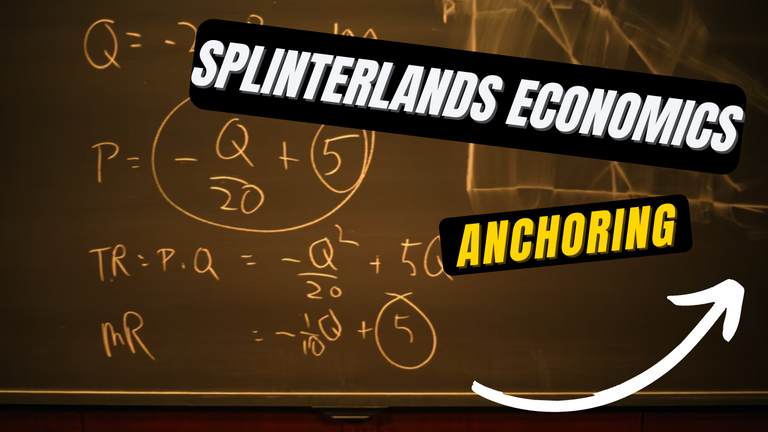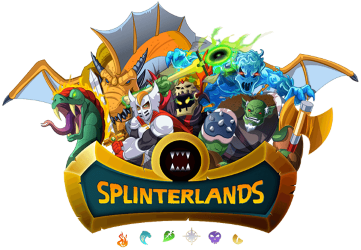Hello everyone! We are back again today with another edition of Splinterland Economics - a series in which we introduce a basic economic concept and then apply it to Splinterlands. If this is your first time reading, just to tell you a little bit about myself: my day job is in an unrelated area but I consider myself a little bit of economics nerd - I read a little (or maybe way, way) more news than I should, double majored in econ, and am obsessed with optimization. I love the way Splinterlands is equal parts card game and resource allocation game. My goal with these articles is to share a little bit of what I know with you all.
Our subject today has to deal with how we view the value of our assets. And while you may think that determining values should be a simple process, it isn't quite as easy as it sounds. Yep, today is another day where we'll be diving into a behavioral economics topic and examine how human beings are bad at making rational decisions. Today, we'll be talking about Anchoring!

What is Anchoring?

Whether it is a physical object you own in real life or a digital object such as a security or NFT, we all have values that we place on items or things in our possession. Right now you may be thinking "this is a stupid subject, all you have to do is to look at the price tag or what is selling for on the exchanges". And if you are looking to determine the fair price or value of something, then you are right and that is exactly how you should be doing things. Emphasis on SHOULD. Because it turns out that people tend to bias their guesses or valuations of items - the future value of something, or some other unknown value, for example - towards particular values.
Perhaps it is the first price you saw on something, or the price you bought it at, or even a random number you saw just before you walked into the room, but you are highly likely to have a bias in your predictions based on initial impressions or recent histories of whatever object we happen to be looking at. You may have heard the disclaimer that past performance is not a guarantee of future results. Anchoring is one example of why this disclaimer is required in the first place - we will often subconsciously use recent history as a predictor of future results, even if it may not make sense to do so.

Anchoring applies to more than just our valuations of securities. Offering an inferior option - for example, a movie theater popcorn size half the size for just 25 cents less - is one example of a company attempting to use anchoring. When you see a "bad" option, it makes the "fair" options seem that much better! And similarly, if you have ever entered a negotiation and seen a situation where the first offer is completely off from a fair value, this is most likely an attempt from the negotiator to "anchor" the negotiated value to a much higher or lower value than may otherwise be agreed upon.
How do we apply it to Splinterlands?

Splinterlands is a game of asset allocation, and for most players that involves buying and selling different types of assets. Being able to accurately determine the values of assets which you own or are considering purchasing or selling can allow you to make the best decisions about the ways in which you manage your collection and crypto balances. Whether you are looking into buying cards, SPS, land, or some other aspect of the Splinterlands universe, everything is going to have a price tag on it. And that means that it is possible to have your decisions impacted by anchoring.
Anchoring will affect nearly every player, and not just yourself. This means that the game markets will not always reflect the intrinsic value of particular goods or assets. For example, taking a look at various channels on discord where Splinterlands players often hang out can give you a look into how players are feeling about their investments and market conditions, and possibly give you some insight into whether anchoring is playing a prominent role. Seeing a lot of chat about buy-in prices or comparisons to unrelated markets or trends? That could be a big hint that there may be an anchoring bias.
Why should we care?

Notably, even when you are looking for it, it is very difficult to prevent the anchoring effect from influencing your valuations and predictions. However, being aware of anchoring biases in yourself and others allows us to do our best to more accurately evaluate the value of our own assets and make better decisions when it comes to our investments and/or capital. It can also allow us to more accurately gauge market sentiments and potentially see where there may be pricing inefficiencies.
Knowing about anchoring can also help you to be a better negotiator. Remember that the stakes from negotiation could be huge. It may not make much of a difference while haggling at a flea market, but if that negotiation is over salary or a large purchase like a vehicle or home then even a small percentage difference in the final price can have a large dollar value. If you are bargaining over something at some point, you can put anchoring to work for you - try starting off with a more favorable starting offer than you might expect to end up at - the results may surprise you!
Thank you so much for reading all the way to the end. Interested in seeing some more of my writing in the future? Be sure to give me a follow! In the meantime, if you'd like to see some of my recent posts:
Nobody Expects the In-Quix-ition - Using the Dragon Splinter in Battle! - Last week's battle challenge, featuring Quix, the Devious!
Splinterlands Economics: Nudging - An introduction to nudging, and how we can can use it to our benefit in Splinterlands.
Splinterlands Economics: Loss Aversion - An introduction to loss aversion, and how being aware of it can help us in Splinterlands.
Thinking about giving Splinterlands a try but haven't signed up yet? Feel free to use my referral link: https://splinterlands.com?ref=bteim, and be sure to reach out to me if you have any questions!
All images used in this article are open source and obtained from Pixabay or Unsplash. Thumbnails borrowed with permission from the Splinterlands team or made in Canva.
example: $4 Chaos Legion pack
Unless you get utilities and rush gambling, statistically it is cheaper to pick up individual cards
It is also interesting to see how cheap gets cheaper (buying the dip but it keeps on dipping! like SPS). Anchor becomes a moving goal post.
Yep, that is a great example!